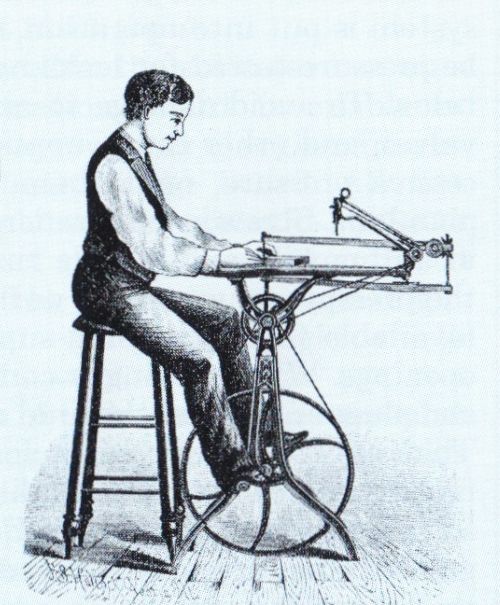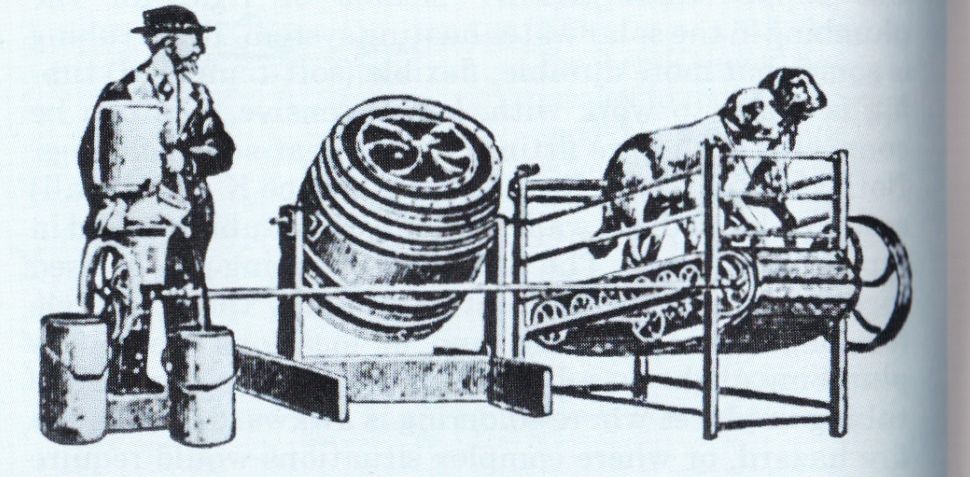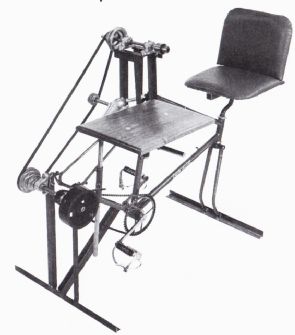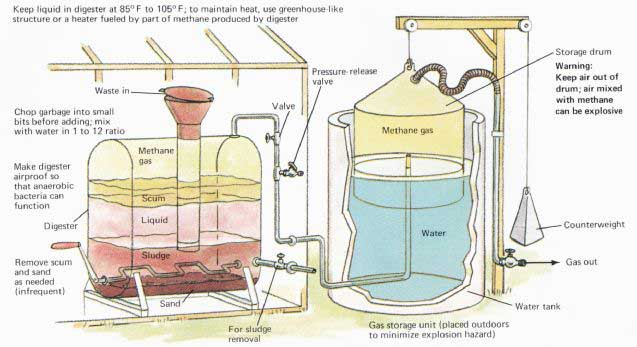From Pedal Power to Atomic Fusion
There are a great many ways to obtain energy, some old, some fashionable, some expensive, and a few still technological dreams. Several of the newest energy sources are inherently large-scale and can produce useful amounts of energy only at the industrial level. Others are of a scale small enough to be used by an individual household. These include such sources as bicycle power and methane digesters.
Bicycles have been with us for about a century and have proven to be the most efficient way to transport people. The intrinsically high mechanical efficiency of the cycle mechanism can be transferred to other activities in various ways, a few of which are shown on this page. Unfortunately, such pedal devices are limited by the comparatively small amount of power that humans can generate compared to the output of machines using fossil fuels or waterpower.
A new and promising source of energy, still in the experimental stage, is the methane digester. This device represents a kind of cooperation with billions of anaerobic bacteria: we feed them refuse, they provide us with methane. The process should not be confused with means for disposing of human wastes that use aerobic bacteria, as in some flushless toilets. Aerobic bacteria use oxygen to convert refuse into carbon dioxide, fertilizer, and water. Anaerobic bacteria, on the other hand, work in a tank that contains no air at all.
Ethyl alcohol-a superb, nonpolluting 115-octane fuel-can be made from sugarcane and other farm crops with the help of yeast cells. The process is the same as that used to make hard liquor. Although the basic technology is thousands of years old, it does not yet offer an economic alternative to other industrial fuels.

----------- Muscle power: Machines that use leg power tree the hands and triple the energy output of the human body as compared to arm power. Pedal-operated jigsaws, like the one shown here, were being manufactured and sold long be the turn of the century. Sewing machines with treadles, dating from the same era, are still in use.

----------- Animal power--not just horses and oxen but dogs as well---was widely used in America a hundred years ago. The treadmill is being used to run a cream separator but could be disconnected and attached to run the butter churn at center.

--------------- A homemade pedal machine: Versatile pedal machine can he made at home by following instructions given in the hook on pedal power listed in Sources and resources on the next page. With appropriate attachments the machine can be used to polish, buff, drill, churn butter, peel potatoes, grind meat, knead dough, mill flour, and make ice cream Some large-scale Prospects Geothermal energy. Deep in the earth the tempera ture is very high. In some areas, such as California and Iceland, water has been trapped far below the surface and turned to steam. The steam can be tapped by drilling or by taking it from fissures and its energy used for heating or to run steam-electric generators. Rather than rely on natural water pockets, plans are underway to drill to the heat-bearing strata and pump water down so that it heats and returns as steam.
Waste conversion. I high-temperature processes under development are hydrogenation and pyrolysis. Both require that an effective, large-scale system for collecting organic waste be devised. Either process will produce about 2 barrels of oil from 1 ton of manure, paper, wood, garbage, or agricultural refuse.
Magnetohydrodynamics. Conventional generators produce electricity by passing wires through magnetic fields. A magnetohydrodynamic generator replaces the wire with a current-conducting fluid pressured by heat to pass through the fields. Since no moving parts are used, the process is more efficient than conventional generators. In addition, less heat is wasted. Unfortunately, costly temperature-resistant materials are needed to contain the hot fluid.
Hydrogen fusion. The sun burns hydrogen as its principal fuel by a process known as atomic fusion. If fusion could be duplicated in a controlled fashion on earth, a millennium of endless energy would he at hand, since the fuel is available in seawater in almost limitless supply. The residue of the process is helium, which, unlike by-products of atomic fission, is nonpolluting.
Methane Digesters
A homeowner can manufacture his own natural gas with the help of a methane digester and the cooperation of vast numbers of bacteria that convert manure, vegetable matter, and other waste into methane, or marsh gas. The methane can be used for heating, lighting, and cooking. It can even power an internal combustion engine provided the engine is modified slightly. (During World War II in Europe, methane was frequently used to run automobiles; instead of a fuel tank the methane was stored in huge bags tied to the tops of cars.) To produce methane in usable quantities, a large amount of animal waste is required. (The waste can be partly vegetable matter, but a greater portion of it should be manure; otherwise, a substantial percentage of the gas produced will be carbon dioxide, a product that is useless as a fuel.) For example, to make enough gas to meet the cooking needs of one family, the manure ii one or two horses or cows, or of several hundred chickens, must be in steady supply. For this reason a farm is the best location for a methane digester. In addition, a farm will benefit from the sludge left over titter the bacteria have finished digesting the manure- the sludge makes excellent fertilizer.
Operation of the digester itself is simple. The main job is to collect the waste to feed the digester and to dispose iii the sludge that accumulates inside it. Note, however, that a mixture of methane and oxygen can be explosive; for this reason the storage drum must be airtight and located far from any buildings.
Alcohol as a Fuel
Alcohol offers a tantalizing prospect as a replacement for ordinary gasoline used in cars. It enhances performance, decreases pollution, and is gentler on engines. Its two most common forms are methyl alcohol (methanol) and ethyl alcohol (ethanol). Both can be produced from such organic materials as sugar, corn, and wood.
Of the two, ethyl alcohol is considerably more desirable as a fuel. Ethanol mixes readily with gasoline in any proportion; methanol does not. Ethanol works as well as gasoline an internal combustion engine; engines using methanol as fuel are sometimes difficult to start. Ethanol can be made at home by fermenting and distilling agricultural products that contain sugar; methanol titlist be made in a commercial plant. As a result, the use I methyl alcohol as a power source is still in the experimental stage, while ethyl alcohol is already in wide use as "gasohol," a blend of ethanol and gasoline.
An interesting characteristic of ethyl alcohol is that you can "grow" it yourself. There are obstacles, however.
One is the fact that alcohol production is strictly regulated by federal law. Another is the relative inefficiency of small-scale distilling. Different crops will produce different yields of ethanol. An acre of sugarcane or sugar beets will yield about 500 gallons of alcohol; the same acreage of potatoes about 250 gallons; corn about 150 gallons; and wheat about 75 gallons. A great deal of labor is involved in harvesting these crops, then processing them batch by batch through a mash barrel and a still, with each batch requiring several days of fermentation. In addition, fuel is consumed in keeping the mash barrel heated to the optimum temperature of 172°F unless some alternative, such as solar heating, is brought into service. One hope, issuing from the laboratory, is a recently discovered fungus that can convert raw cellulose from such substances as wood and waste paper into the glucose (sugar) that the fungi in brewer's yeast subsist on. Fuel alcohol productoin from such a plentiful raw material will then be more attractive.

----------- Digester converts waste to methane gas, which then lows via pipe to storage drum. The drum has no bottom, and as the gas gradually fills it, the drum rises farther and farther above the water. Pressure of methane at outlet is regulated by counter weight, which reduces pressure by offsetting the downward push exerted by the weight of the drum on methane inside it.
==============